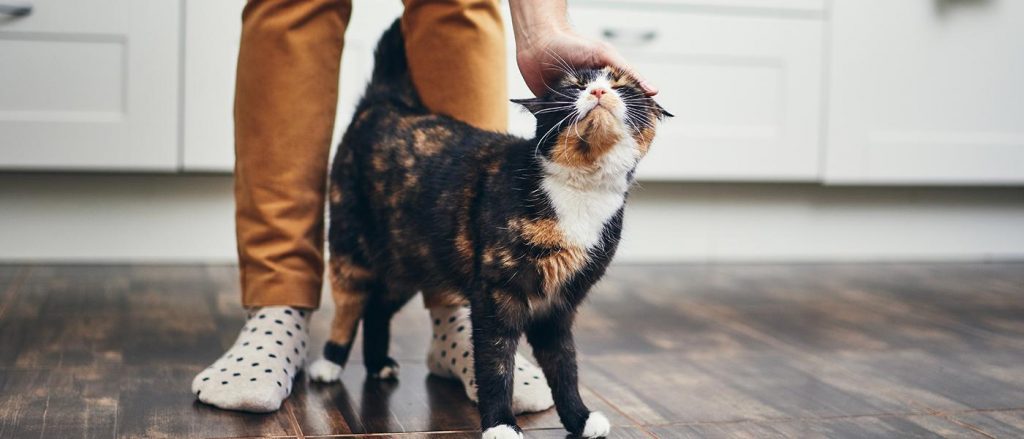Deciphering Cat Body Language Around Food

Mealtime for your cat may be very straightforward – you offer the food and your cat is right there to eat it, or you offer food and kitty nibbles at will throughout the day. In some households though, especially where there are multiple cats, mealtime may be a little more complex and requires finesse to make sure everything remains peaceful and happy.
If you’ve been wondering what your cat’s body language means when she’s around food, here are some clues to help you better understand what might be going on.
Sitting by Empty Food Bowl
Let’s start with an easy one. Your cat takes great comfort in familiar routines so her internal clock lets her know when it’s about to become mealtime. Even though you may never be late in offering food at the same time every day, she may still sit there in anticipation. If you have a rescued cat who previously had to hunt for meals, she may always retain concern over whether there’s enough food. This can also be the behavior of a cat who is put on a weight reduction regimen. Sometimes a cat will sit by the food bowl and meow as it gets closer to mealtime. Every time you walk into the kitchen you may be greeted by a vocal reminder.
Unless you free-feed by leaving dry food available, make sure to take food bowls up in-between meals. Just leave fresh water available. To ensure you don’t reinforce constant meowing, don’t give in and offer food earlier than you normally do just to quiet the cat because it sends a message that meowing works. Instead, make sure there’s enough environmental stimulation to keep her busy so focusing on an upcoming meal isn’t her only activity. Engage in interactive play sessions at least twice a day, and leave interesting (and safe) solo toys out for her. Create environmental enrichment through the addition of things such as a cat tree, window perches, cat shelves, cat-interest videos, and so on. If your cat still insists on sitting at the feeding station, don’t acknowledge it until the actual scheduled mealtime. Just be sure the feeding schedule is correct for your cat’s age, health, and activity level. If you’re concerned you may not be feeding enough, talk with your veterinarian. You may want to incorporate the use of puzzle feeders as well, to help your cat worry less about where the next meal is coming from. Puzzle feeders can be created for both dry or wet food and can be a helpful and fun addition to a cat’s enrichment, especially for a kitty on a diet. For dry food, we recommend Complete Health with Wholesome Grains to help provide a nutritious and balanced diet. As for wet food, cats love variety in their diet, so they’re bound to find a flavor they love in our Complete Health Variety Packs. Do an online search for cat puzzle feeders and you’ll see many companies make them. You can even make homemade ones.
Rubbing Against Your Legs as You Walk to the Kitchen to Prepare Meal
Flank rubbing is a cat’s way of bonding in a very respectful way, as one cat may flank rub a higher-ranking cat. As you walk to the kitchen, especially when your cat anticipates her meal is about to be prepared, it’s a way of showing excitement and acknowledging that you’re a loved member of her family.
Eating Only When You are Present
When you place the food bowl down for your cat and walk away, only to have her pace back and forth between where you are and her food bowl, it may mean she wants you to stay with her. She may need the extra security of having you physically nearby. She may like the extra comfort of knowing you’re there, but if she seems afraid to eat without you then it’s time to look closer at the environment to see what needs to be done to create a secure, peaceful meal experience. For example, make sure she hasn’t been routinely disturbed by other cats, the family dog or other family members while eating.
Paw Scooping
If your cat eats by scooping the food out of the bowl with her paw, it could mean a couple of things. The bowl could be an incorrect size and shape for her. If the bowl is narrow and deep, it may be uncomfortable to put her head into it to reach the food without squishing her whiskers. A cat’s whiskers are very sensitive and getting bent can create discomfort. Another possible reason is that it reduces her ability to see what’s going on in her environment. If a multipet home, it can be a disadvantage for her to have limited visual ability, especially when eating. Make sure the food bowl is low and wide enough for her to comfortably eat without bent whiskers or creating a visual block.
Paw scooping of dry food can sometimes be a playful behavior as well. A cat may develop a habit of scooping a couple of pieces out of the bowl to play a little before eating.
Trying to “Bury” Food
The cat walks over to the bowl, sniffs, and then paws at the floor as if she’s trying to bury the food. Many cat parents interpret this as an insult because the behavior resembles the burying done after elimination. It’s not the cat’s way of saying she hates your food choice. She just may not be hungry and the burying display is part of her survival instinct. In an outdoor setting, a cat wouldn’t want the smell of food in her core area because it could attract predators.
Looking Around While Eating
The cat looks over her shoulder repeatedly or she eats a little and then stops to look around before taking another bite. This could indicate that she’s nervous in the location where her meal is being served or she might be worried another cat is going to threaten her resource. This is a behavior more commonly seen in multicat environments or one where mealtime is in a hectic room (ex: several people moving around the kitchen preparing the family meal while kitty is trying to eat).
To address this, look at food bowl placement. Don’t put food and water bowls right up against the wall because it prevents the cat from being able to see what’s happening in the room. Slide the bowls out so your cat can stand between the wall and the bowl in order to have a good view of the room. In a multicat household where a cat gets nosed out of the bowl or if there’s multicat tension, separate feeding stations to create more security. feeding stations may need to be set up in various rooms to prevent mealtime intimidation.
Resource Guarding Behavior or Aggressive Display
A cat is a social animal, but the social structure is built around the availability of resources. Food is obviously a critical resource and if a cat feels it’s in danger, she needs to guard it. This behavior can present as a display of aggression if someone (cat, dog, or family member) comes close while she’s eating, or she may hang out in the feeding area in order to let others know this is her turf.
Make sure there are adequate feeding stations so no cat feels threatened or intimidated by a resource-guarding kitty. Don’t set up one big food bowl for all cats to eat from. Everyone should have their own safe meal location.
Puzzle feeders may also help cats realize food is readily available. Puzzle feeders also provide the opportunity of having some fun as cats “hunt” for their food.
Cats aren’t social eaters and it can create stress to be close together during meals. Even the best kitty friends may feel more comfortable with a little space between each other while eating. Sometimes the best solution is to feed in separate locations. What’s most important is that mealtime is peaceful and secure.
Nosing into Another Cat’s Food Bowl
A cat may eat her own food way too fast and then push companion cats out of their own bowls in order to eat their food. Sometimes a cat may ignore her own food in order to eat another cat’s food before returning to her own bowl.
A cat who displays this behavior may be concerned there won’t be enough food. A former stray may engage in this behavior even though there’s plenty of food being offered at each meal. It can also be intimidation that a higher-ranking cat may display to a lower-ranking kitty.
Make sure the cats are fed far enough apart. You can either monitor mealtime to prevent stealing or set up feeding stations in separate rooms.
Eating Too Fast
A cat who eats too fast may end up vomiting it all back up. First, make sure there isn’t an underlying medical cause for the behavior. If your cat gets a clean bill of health, it may be that she’s worried there isn’t enough food for her or it could be that you’ve spaced the meals too far apart and she’s just way too hungry. Cats have small stomachs so multiple small meals per day are more natural than one or two big meals. Talk to your veterinarian about how much and how often to feed.
To slow your cat down during meals, consider using a slow-feeder bowl. These are commonly used with dogs. The bowls have obstacles built in so the animal has to work around them to get the food. You can also feed your cat out of a muffin tin where you place a little food in each compartment. If feeding wet food, smush the food down so it takes a little longer for your cat to get at it. Puzzle feeders are good for fast eaters as well.
Tilting Head and Eating on One Side of the Mouth
This is typically a medical issue due to something such as a tooth problem or mouth pain. If you see this behavior while eating, your cat needs to be seen by the veterinarian.
Have Questions About Your Cat’s Behavior Around Food?
Making mealtime a success should be a top priority for cat parents. If you’re unsure of what your cat is trying to tell you when it comes to mealtime, start by talking to your veterinarian to rule out any underlying medical reason for the behavior.





